Management Accounting Report: Analysis of IKEA's Accounting Practices
VerifiedAdded on 2023/01/06
|21
|5486
|92
Report
AI Summary
This report delves into the realm of management accounting (MA), focusing on its application within IKEA, a prominent furniture manufacturer in the UK. The introduction establishes MA as a crucial process for generating both financial and non-financial data to facilitate sound business judgments. The report examines various MA systems, including financial management, auditing, planning, cost accounting, controlling, and decision-making. It differentiates between management and financial accounting, emphasizing the former's role in internal decision-making. The core of the report explores diverse costing methods and their impact on income statements, alongside an assessment of various planning tools used for budgetary control. Furthermore, the report highlights the benefits and integration of MA systems within organizational processes, using IKEA as a case study. The report also includes an analysis of different MA reporting methods, such as inventory management and performance reports. The report concludes with an analysis of how the MA system is used to recognize and solve many business-related financial challenges. This report provides insights into how IKEA utilizes MA principles for effective financial management and strategic decision-making.
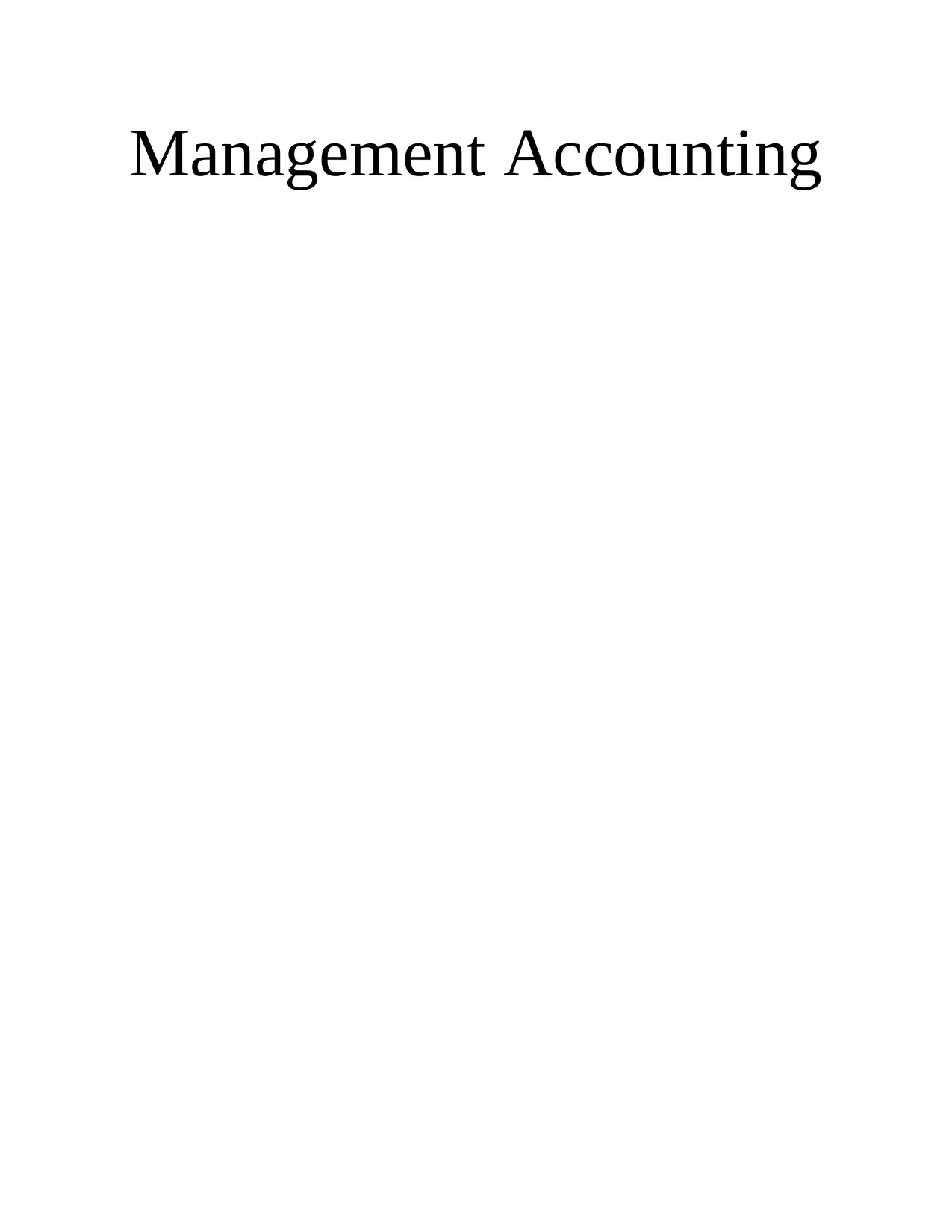
Management Accounting
Paraphrase This Document
Need a fresh take? Get an instant paraphrase of this document with our AI Paraphraser

Contents
INTRODUCTION...........................................................................................................................3
TASK 1............................................................................................................................................3
P1 MA and essential requirement of 4 MA system.....................................................................3
P2. Various method of management accounting reporting.........................................................6
TASK 2............................................................................................................................................8
P3. Preparation of income statements with different costing scheme.........................................8
TASK 3..........................................................................................................................................13
P4 Advantages and disadvantages of different planning tools used for budgetary control.......13
TASK 4..........................................................................................................................................16
P5. Comparison between organisations regarding using of MA system to solve problems......16
CONCLUSION..............................................................................................................................16
REFERENCES..............................................................................................................................17
INTRODUCTION...........................................................................................................................3
TASK 1............................................................................................................................................3
P1 MA and essential requirement of 4 MA system.....................................................................3
P2. Various method of management accounting reporting.........................................................6
TASK 2............................................................................................................................................8
P3. Preparation of income statements with different costing scheme.........................................8
TASK 3..........................................................................................................................................13
P4 Advantages and disadvantages of different planning tools used for budgetary control.......13
TASK 4..........................................................................................................................................16
P5. Comparison between organisations regarding using of MA system to solve problems......16
CONCLUSION..............................................................................................................................16
REFERENCES..............................................................................................................................17
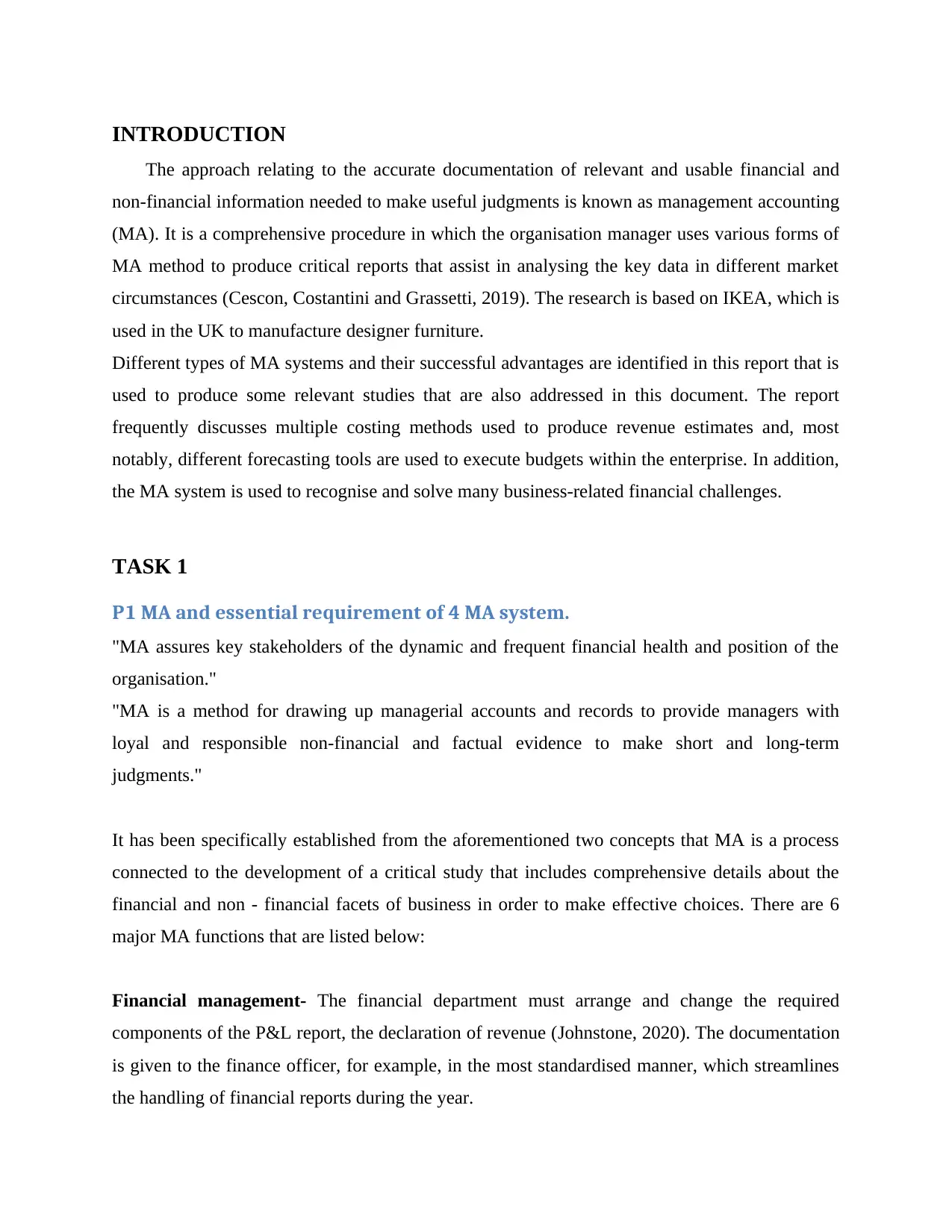
INTRODUCTION
The approach relating to the accurate documentation of relevant and usable financial and
non-financial information needed to make useful judgments is known as management accounting
(MA). It is a comprehensive procedure in which the organisation manager uses various forms of
MA method to produce critical reports that assist in analysing the key data in different market
circumstances (Cescon, Costantini and Grassetti, 2019). The research is based on IKEA, which is
used in the UK to manufacture designer furniture.
Different types of MA systems and their successful advantages are identified in this report that is
used to produce some relevant studies that are also addressed in this document. The report
frequently discusses multiple costing methods used to produce revenue estimates and, most
notably, different forecasting tools are used to execute budgets within the enterprise. In addition,
the MA system is used to recognise and solve many business-related financial challenges.
TASK 1
P1 MA and essential requirement of 4 MA system.
"MA assures key stakeholders of the dynamic and frequent financial health and position of the
organisation."
"MA is a method for drawing up managerial accounts and records to provide managers with
loyal and responsible non-financial and factual evidence to make short and long-term
judgments."
It has been specifically established from the aforementioned two concepts that MA is a process
connected to the development of a critical study that includes comprehensive details about the
financial and non - financial facets of business in order to make effective choices. There are 6
major MA functions that are listed below:
Financial management- The financial department must arrange and change the required
components of the P&L report, the declaration of revenue (Johnstone, 2020). The documentation
is given to the finance officer, for example, in the most standardised manner, which streamlines
the handling of financial reports during the year.
The approach relating to the accurate documentation of relevant and usable financial and
non-financial information needed to make useful judgments is known as management accounting
(MA). It is a comprehensive procedure in which the organisation manager uses various forms of
MA method to produce critical reports that assist in analysing the key data in different market
circumstances (Cescon, Costantini and Grassetti, 2019). The research is based on IKEA, which is
used in the UK to manufacture designer furniture.
Different types of MA systems and their successful advantages are identified in this report that is
used to produce some relevant studies that are also addressed in this document. The report
frequently discusses multiple costing methods used to produce revenue estimates and, most
notably, different forecasting tools are used to execute budgets within the enterprise. In addition,
the MA system is used to recognise and solve many business-related financial challenges.
TASK 1
P1 MA and essential requirement of 4 MA system.
"MA assures key stakeholders of the dynamic and frequent financial health and position of the
organisation."
"MA is a method for drawing up managerial accounts and records to provide managers with
loyal and responsible non-financial and factual evidence to make short and long-term
judgments."
It has been specifically established from the aforementioned two concepts that MA is a process
connected to the development of a critical study that includes comprehensive details about the
financial and non - financial facets of business in order to make effective choices. There are 6
major MA functions that are listed below:
Financial management- The financial department must arrange and change the required
components of the P&L report, the declaration of revenue (Johnstone, 2020). The documentation
is given to the finance officer, for example, in the most standardised manner, which streamlines
the handling of financial reports during the year.
⊘ This is a preview!⊘
Do you want full access?
Subscribe today to unlock all pages.

Trusted by 1+ million students worldwide
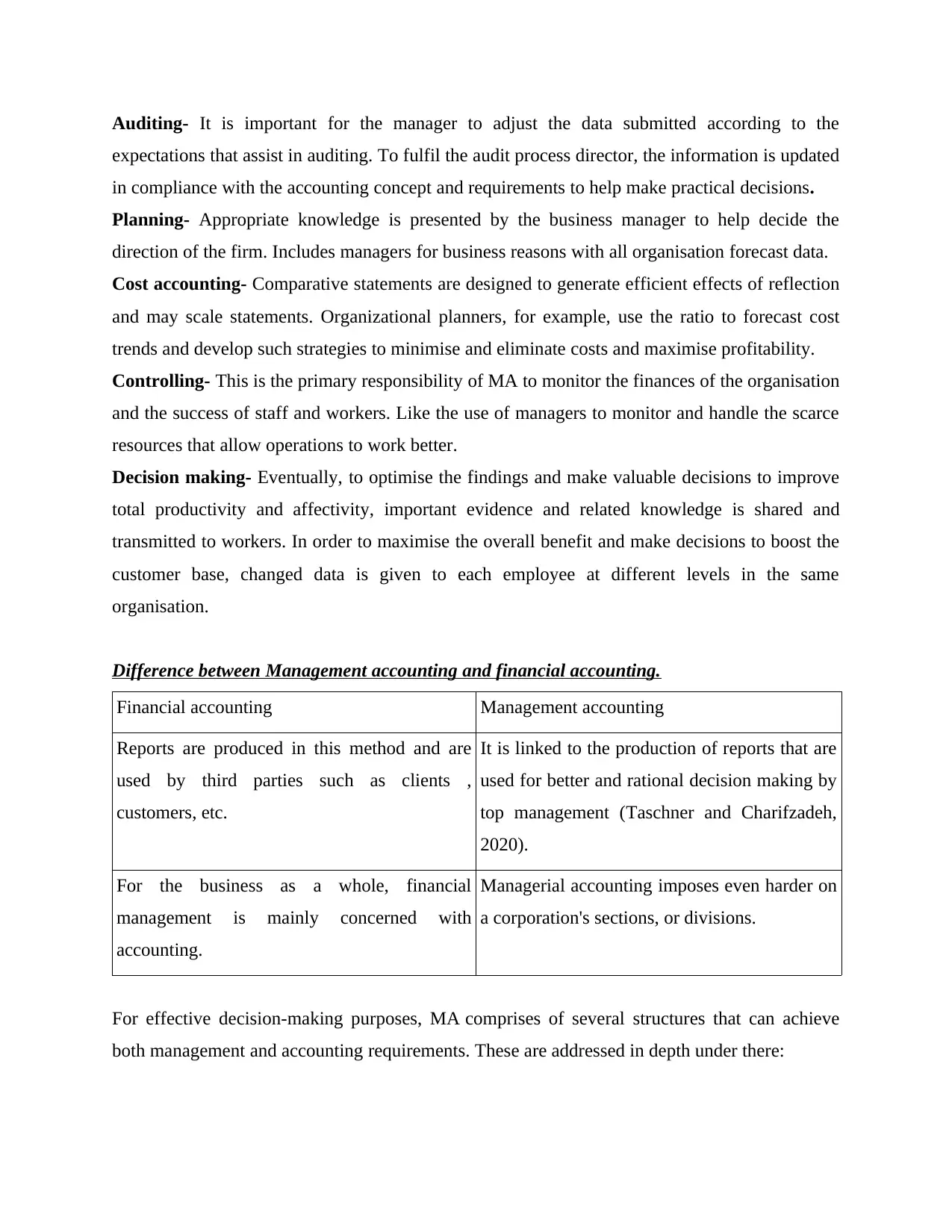
Auditing- It is important for the manager to adjust the data submitted according to the
expectations that assist in auditing. To fulfil the audit process director, the information is updated
in compliance with the accounting concept and requirements to help make practical decisions.
Planning- Appropriate knowledge is presented by the business manager to help decide the
direction of the firm. Includes managers for business reasons with all organisation forecast data.
Cost accounting- Comparative statements are designed to generate efficient effects of reflection
and may scale statements. Organizational planners, for example, use the ratio to forecast cost
trends and develop such strategies to minimise and eliminate costs and maximise profitability.
Controlling- This is the primary responsibility of MA to monitor the finances of the organisation
and the success of staff and workers. Like the use of managers to monitor and handle the scarce
resources that allow operations to work better.
Decision making- Eventually, to optimise the findings and make valuable decisions to improve
total productivity and affectivity, important evidence and related knowledge is shared and
transmitted to workers. In order to maximise the overall benefit and make decisions to boost the
customer base, changed data is given to each employee at different levels in the same
organisation.
Difference between Management accounting and financial accounting.
Financial accounting Management accounting
Reports are produced in this method and are
used by third parties such as clients ,
customers, etc.
It is linked to the production of reports that are
used for better and rational decision making by
top management (Taschner and Charifzadeh,
2020).
For the business as a whole, financial
management is mainly concerned with
accounting.
Managerial accounting imposes even harder on
a corporation's sections, or divisions.
For effective decision-making purposes, MA comprises of several structures that can achieve
both management and accounting requirements. These are addressed in depth under there:
expectations that assist in auditing. To fulfil the audit process director, the information is updated
in compliance with the accounting concept and requirements to help make practical decisions.
Planning- Appropriate knowledge is presented by the business manager to help decide the
direction of the firm. Includes managers for business reasons with all organisation forecast data.
Cost accounting- Comparative statements are designed to generate efficient effects of reflection
and may scale statements. Organizational planners, for example, use the ratio to forecast cost
trends and develop such strategies to minimise and eliminate costs and maximise profitability.
Controlling- This is the primary responsibility of MA to monitor the finances of the organisation
and the success of staff and workers. Like the use of managers to monitor and handle the scarce
resources that allow operations to work better.
Decision making- Eventually, to optimise the findings and make valuable decisions to improve
total productivity and affectivity, important evidence and related knowledge is shared and
transmitted to workers. In order to maximise the overall benefit and make decisions to boost the
customer base, changed data is given to each employee at different levels in the same
organisation.
Difference between Management accounting and financial accounting.
Financial accounting Management accounting
Reports are produced in this method and are
used by third parties such as clients ,
customers, etc.
It is linked to the production of reports that are
used for better and rational decision making by
top management (Taschner and Charifzadeh,
2020).
For the business as a whole, financial
management is mainly concerned with
accounting.
Managerial accounting imposes even harder on
a corporation's sections, or divisions.
For effective decision-making purposes, MA comprises of several structures that can achieve
both management and accounting requirements. These are addressed in depth under there:
Paraphrase This Document
Need a fresh take? Get an instant paraphrase of this document with our AI Paraphraser

Cost Accounting system- It is often known as a form of inventory pricing that the organisation
uses to quantify the cost of its goods to aid in market control, quality estimation and product
evaluation. This scheme can be used in IKEA to measure the overall expense engaged in
multiple operations and procedures. It may also be beneficial for companies to reduce extra
expenses and increase the allocation of funds in a successful activity. By utilising this
framework, the business can remove activities that require higher costs which are not beneficial
for performance. The FIFO approach suggests that the product that is first bought must first be
sold at a feasible price in order to offset the company's expenses. On the other hand, AVCO is a
tool of a standardised approach to market inventory at all weighted average costs of sales. Any
time inventory is published, an average cost is calculated to further increase the firm's revenue
profit. It is also recognised that ensuring that no new expenses are expended on any wasteful
operation is an integral condition in cost accounting. Some of the basic necessity is as follow:
The cost accounting system must be personalised, functional, simple and reliable of
fulfilling a user's needs.
The costing method by adding detailed and redundant details does not lose usefulness.
By using network research for the development of the framework, a properly phased plan
could be planned.
Inventory Management System- Company inventory is handled successfully throughout this
MA framework. During the year, the most useful use of this method for industry would be to
manage demand and supply (Doktoralina and Apollo, 2019). In order to accommodate the
overall demand of the consumer, the respective organisation should use this approach as it can
keep accurate details on total finished products, raw materials and items in transit. The basic
necessity of this method is to facilitate the preservation of sufficient calculation of manufactured
products stored in warehouses in order to satisfy consumer requirements. Any methods such as
ROP are used in this method, which basically means the reorder stage from which the business
must order again such that the development and procurement phase stays going. Likewise in
IKEA, where the quantity of raw resources short is used by the manager to rearrange the
quantities needed to produce designer furniture. The other JIT method is helpful to the respective
business as it allows to directly ordering the distributor whenever possible.
Essential requirement: Stock management system is essential for companies in order to manage
various kinds of inventories like raw material, work in progress and finished goods. In IKEA
uses to quantify the cost of its goods to aid in market control, quality estimation and product
evaluation. This scheme can be used in IKEA to measure the overall expense engaged in
multiple operations and procedures. It may also be beneficial for companies to reduce extra
expenses and increase the allocation of funds in a successful activity. By utilising this
framework, the business can remove activities that require higher costs which are not beneficial
for performance. The FIFO approach suggests that the product that is first bought must first be
sold at a feasible price in order to offset the company's expenses. On the other hand, AVCO is a
tool of a standardised approach to market inventory at all weighted average costs of sales. Any
time inventory is published, an average cost is calculated to further increase the firm's revenue
profit. It is also recognised that ensuring that no new expenses are expended on any wasteful
operation is an integral condition in cost accounting. Some of the basic necessity is as follow:
The cost accounting system must be personalised, functional, simple and reliable of
fulfilling a user's needs.
The costing method by adding detailed and redundant details does not lose usefulness.
By using network research for the development of the framework, a properly phased plan
could be planned.
Inventory Management System- Company inventory is handled successfully throughout this
MA framework. During the year, the most useful use of this method for industry would be to
manage demand and supply (Doktoralina and Apollo, 2019). In order to accommodate the
overall demand of the consumer, the respective organisation should use this approach as it can
keep accurate details on total finished products, raw materials and items in transit. The basic
necessity of this method is to facilitate the preservation of sufficient calculation of manufactured
products stored in warehouses in order to satisfy consumer requirements. Any methods such as
ROP are used in this method, which basically means the reorder stage from which the business
must order again such that the development and procurement phase stays going. Likewise in
IKEA, where the quantity of raw resources short is used by the manager to rearrange the
quantities needed to produce designer furniture. The other JIT method is helpful to the respective
business as it allows to directly ordering the distributor whenever possible.
Essential requirement: Stock management system is essential for companies in order to manage
various kinds of inventories like raw material, work in progress and finished goods. In IKEA

company, they track usage of material on daily basis and accordingly they order for new material
as well as produce other products.
Job Costing Systems- for those industries where the variety of goods is wider and more and
more work is needed in various divisions, this accounting method is essential. By using IKEA's
device planner, the exact costs involved with different activities can be calculated and some
arrangements can be made to minimise these costs if the outcomes are not satisfactory.
Price accounting system- In addition to input obtained from consumers on various price points,
this MA method is interested in deciding the true rates of service and product. Through using this
IKEA system manager, the correct and acceptable price of furniture will be set, which will
effectively expand the client base and raise sales overall.
Essential requirement: This accounting system is crucial and essential for companies in order to
set prices at a level so that customers can get satisfied as well as seller also get affordable
revenues. In relation to IKEA Company, they set prices of their products in accordance of market
research and customer’s feedback which contribute in better result.
P2. Various method of management accounting reporting.
MA reports are described as a framework for presenting information about particular types of
operations taking place within an organisation. In the current time, it is important for each report
to be updated as per the latest activity and business mission that helps to define the actual
operating. In order to assess the main conclusions of the organisation, all presentations must be
appropriate and do not mislead managers when reviewing meetings. Some notable studies are
discussed below:
Inventory management report: Specific detail on the volume of storage content is provided in
this report to allow potential requirements to be predicted. Similarly, this report can be prepared
on a regular basis at IKEA to document the overall raw resources used only to manufacture
various designer furniture. In addition, the total inventory in the manufacturing cycle and the
total merchandise ready for sale should be registered. ABC research study, for instance, which
allows management to realise when the most and least valuable asset is required to perform
decently within the product of the business.
Account receivable ageing report- This report provides comprehensive details about those
creditors who, since the extension, have not repaid the unpaid balance (Zandi, Khalid and Islam,
2019). With the assistance of these firms, it is important to decide whether or not card facilities
as well as produce other products.
Job Costing Systems- for those industries where the variety of goods is wider and more and
more work is needed in various divisions, this accounting method is essential. By using IKEA's
device planner, the exact costs involved with different activities can be calculated and some
arrangements can be made to minimise these costs if the outcomes are not satisfactory.
Price accounting system- In addition to input obtained from consumers on various price points,
this MA method is interested in deciding the true rates of service and product. Through using this
IKEA system manager, the correct and acceptable price of furniture will be set, which will
effectively expand the client base and raise sales overall.
Essential requirement: This accounting system is crucial and essential for companies in order to
set prices at a level so that customers can get satisfied as well as seller also get affordable
revenues. In relation to IKEA Company, they set prices of their products in accordance of market
research and customer’s feedback which contribute in better result.
P2. Various method of management accounting reporting.
MA reports are described as a framework for presenting information about particular types of
operations taking place within an organisation. In the current time, it is important for each report
to be updated as per the latest activity and business mission that helps to define the actual
operating. In order to assess the main conclusions of the organisation, all presentations must be
appropriate and do not mislead managers when reviewing meetings. Some notable studies are
discussed below:
Inventory management report: Specific detail on the volume of storage content is provided in
this report to allow potential requirements to be predicted. Similarly, this report can be prepared
on a regular basis at IKEA to document the overall raw resources used only to manufacture
various designer furniture. In addition, the total inventory in the manufacturing cycle and the
total merchandise ready for sale should be registered. ABC research study, for instance, which
allows management to realise when the most and least valuable asset is required to perform
decently within the product of the business.
Account receivable ageing report- This report provides comprehensive details about those
creditors who, since the extension, have not repaid the unpaid balance (Zandi, Khalid and Islam,
2019). With the assistance of these firms, it is important to decide whether or not card facilities
⊘ This is a preview!⊘
Do you want full access?
Subscribe today to unlock all pages.

Trusted by 1+ million students worldwide

should be authorised for customers. This report will be used by the corresponding business
management to document the cumulative amount remaining with the client to figure out which
consumers have no payments since the last date. This will also serve to improve the company's
credit policies such that the benefit can only be gained from the individual whose financial
record is higher.
Performance report- It is known as a report that contains projected revenue & expenses that are
related to actual revenue & expenses. It also aims to determine the efficiency of multiple people
participating in diverse job positions in order to eliminate any dispensaries. Manager will prepare
this report, such as in the above Mention Business, to monitor the results of each employee and
actual revenue and expenditures on distinct activities. In addition, success can be evaluated and
the lack of variables and coordinated methods can be calculated to minimise income and cost
inequalities for an era.
Benefits of MA system
Name of management
accounting system
Benefits
Inventory management
system
It helps to manage demand and supply within the organisation.
It also helps to retain adequate amounts of finished products
stored in warehouses to satisfy consumer requirements.
Price optimisation system This method is applied to produce the most acceptable cost of
products that can be used to bring in new customers and retain
more profit for the business.
Cost accounting system By utilising this framework, the business can eliminate activities
that require higher costs that are not conducive to profitability.
Job costing system This is associated with the estimation of the rate, benefit and loss
outcomes of each task. Each work and expense associated with
various activities can be evaluated in the above listed entity's
sector.
Management accounting system and reporting integrated with organisational process.
management to document the cumulative amount remaining with the client to figure out which
consumers have no payments since the last date. This will also serve to improve the company's
credit policies such that the benefit can only be gained from the individual whose financial
record is higher.
Performance report- It is known as a report that contains projected revenue & expenses that are
related to actual revenue & expenses. It also aims to determine the efficiency of multiple people
participating in diverse job positions in order to eliminate any dispensaries. Manager will prepare
this report, such as in the above Mention Business, to monitor the results of each employee and
actual revenue and expenditures on distinct activities. In addition, success can be evaluated and
the lack of variables and coordinated methods can be calculated to minimise income and cost
inequalities for an era.
Benefits of MA system
Name of management
accounting system
Benefits
Inventory management
system
It helps to manage demand and supply within the organisation.
It also helps to retain adequate amounts of finished products
stored in warehouses to satisfy consumer requirements.
Price optimisation system This method is applied to produce the most acceptable cost of
products that can be used to bring in new customers and retain
more profit for the business.
Cost accounting system By utilising this framework, the business can eliminate activities
that require higher costs that are not conducive to profitability.
Job costing system This is associated with the estimation of the rate, benefit and loss
outcomes of each task. Each work and expense associated with
various activities can be evaluated in the above listed entity's
sector.
Management accounting system and reporting integrated with organisational process.
Paraphrase This Document
Need a fresh take? Get an instant paraphrase of this document with our AI Paraphraser
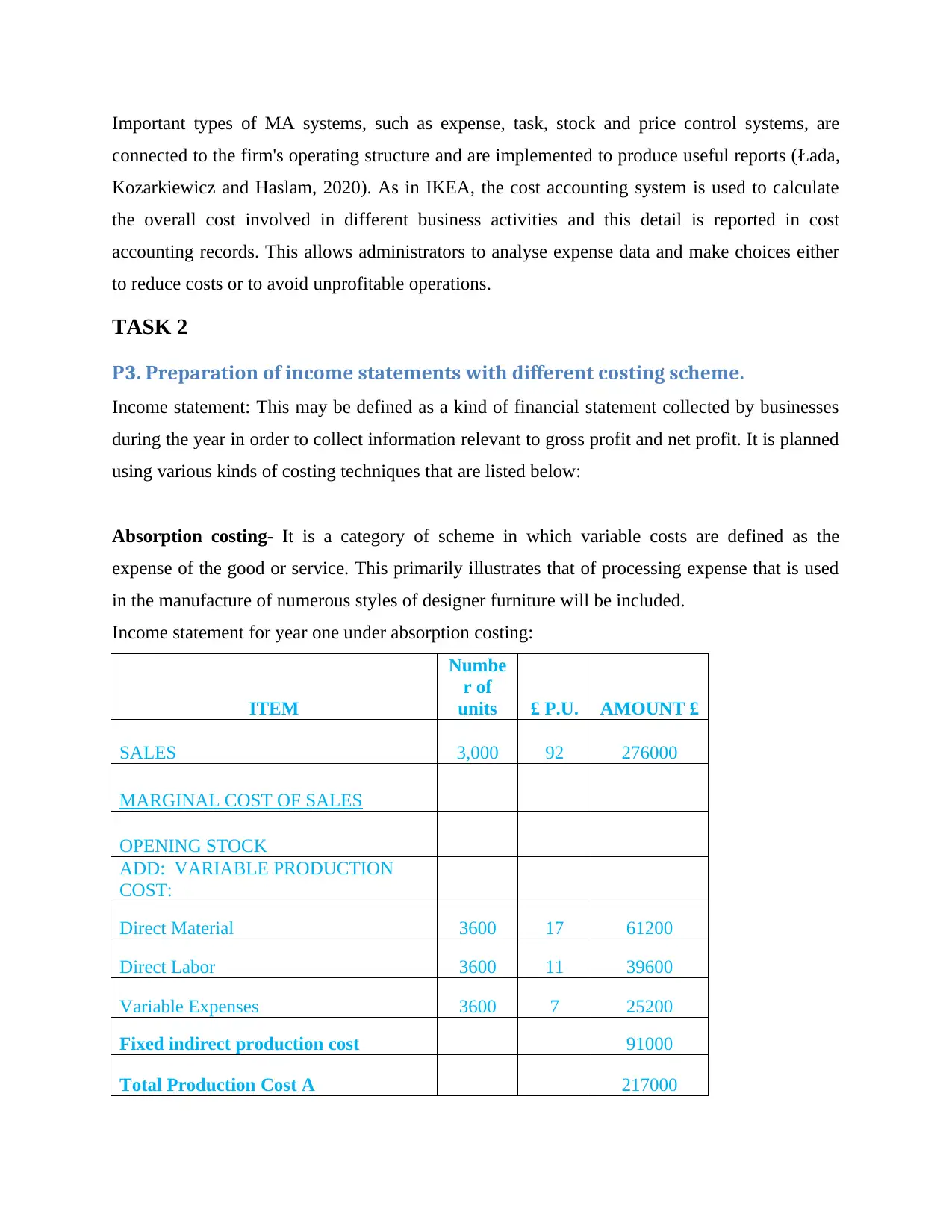
Important types of MA systems, such as expense, task, stock and price control systems, are
connected to the firm's operating structure and are implemented to produce useful reports (Łada,
Kozarkiewicz and Haslam, 2020). As in IKEA, the cost accounting system is used to calculate
the overall cost involved in different business activities and this detail is reported in cost
accounting records. This allows administrators to analyse expense data and make choices either
to reduce costs or to avoid unprofitable operations.
TASK 2
P3. Preparation of income statements with different costing scheme.
Income statement: This may be defined as a kind of financial statement collected by businesses
during the year in order to collect information relevant to gross profit and net profit. It is planned
using various kinds of costing techniques that are listed below:
Absorption costing- It is a category of scheme in which variable costs are defined as the
expense of the good or service. This primarily illustrates that of processing expense that is used
in the manufacture of numerous styles of designer furniture will be included.
Income statement for year one under absorption costing:
ITEM
Numbe
r of
units £ P.U. AMOUNT £
SALES 3,000 92 276000
MARGINAL COST OF SALES
OPENING STOCK
ADD: VARIABLE PRODUCTION
COST:
Direct Material 3600 17 61200
Direct Labor 3600 11 39600
Variable Expenses 3600 7 25200
Fixed indirect production cost 91000
Total Production Cost A 217000
connected to the firm's operating structure and are implemented to produce useful reports (Łada,
Kozarkiewicz and Haslam, 2020). As in IKEA, the cost accounting system is used to calculate
the overall cost involved in different business activities and this detail is reported in cost
accounting records. This allows administrators to analyse expense data and make choices either
to reduce costs or to avoid unprofitable operations.
TASK 2
P3. Preparation of income statements with different costing scheme.
Income statement: This may be defined as a kind of financial statement collected by businesses
during the year in order to collect information relevant to gross profit and net profit. It is planned
using various kinds of costing techniques that are listed below:
Absorption costing- It is a category of scheme in which variable costs are defined as the
expense of the good or service. This primarily illustrates that of processing expense that is used
in the manufacture of numerous styles of designer furniture will be included.
Income statement for year one under absorption costing:
ITEM
Numbe
r of
units £ P.U. AMOUNT £
SALES 3,000 92 276000
MARGINAL COST OF SALES
OPENING STOCK
ADD: VARIABLE PRODUCTION
COST:
Direct Material 3600 17 61200
Direct Labor 3600 11 39600
Variable Expenses 3600 7 25200
Fixed indirect production cost 91000
Total Production Cost A 217000
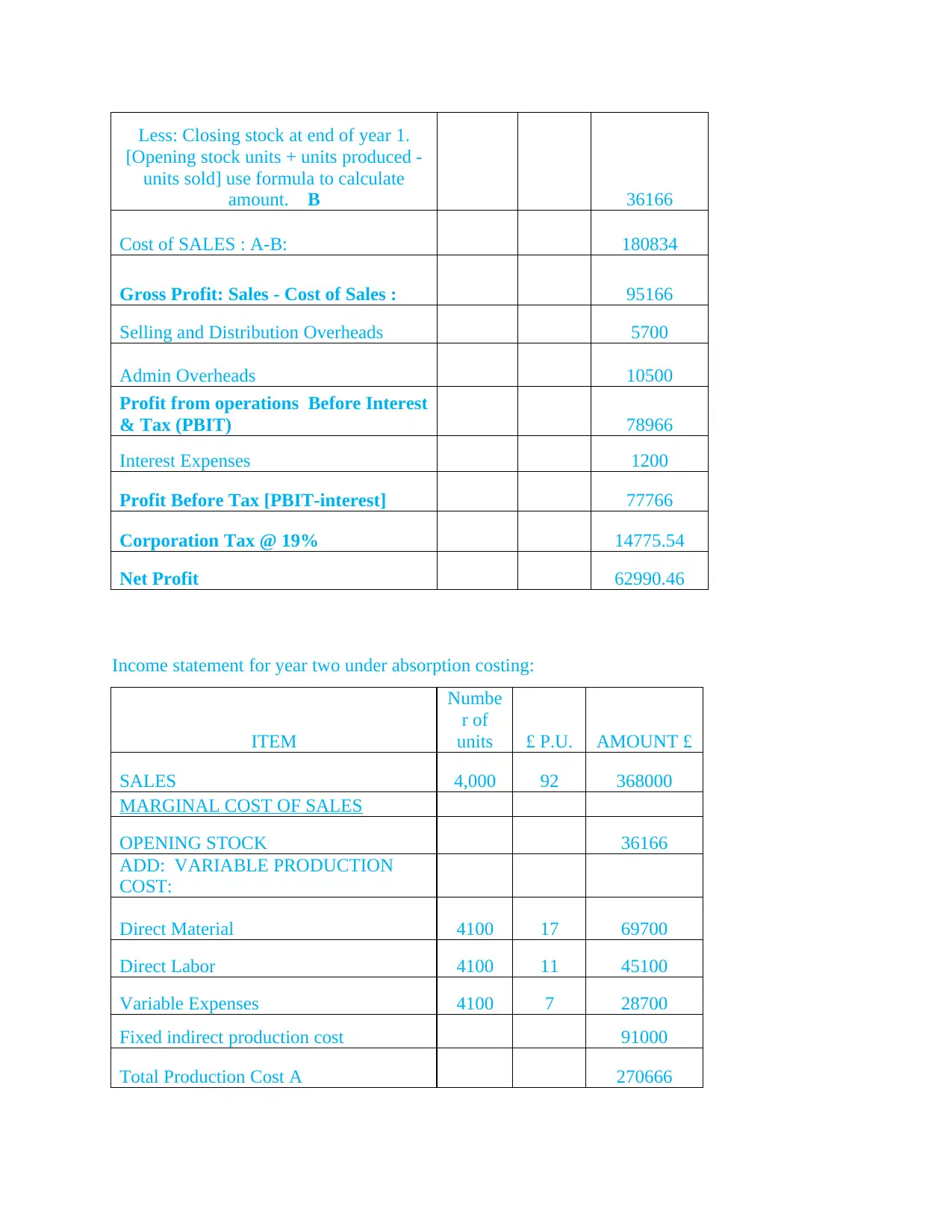
Less: Closing stock at end of year 1.
[Opening stock units + units produced -
units sold] use formula to calculate
amount. B 36166
Cost of SALES : A-B: 180834
Gross Profit: Sales - Cost of Sales : 95166
Selling and Distribution Overheads 5700
Admin Overheads 10500
Profit from operations Before Interest
& Tax (PBIT) 78966
Interest Expenses 1200
Profit Before Tax [PBIT-interest] 77766
Corporation Tax @ 19% 14775.54
Net Profit 62990.46
Income statement for year two under absorption costing:
ITEM
Numbe
r of
units £ P.U. AMOUNT £
SALES 4,000 92 368000
MARGINAL COST OF SALES
OPENING STOCK 36166
ADD: VARIABLE PRODUCTION
COST:
Direct Material 4100 17 69700
Direct Labor 4100 11 45100
Variable Expenses 4100 7 28700
Fixed indirect production cost 91000
Total Production Cost A 270666
[Opening stock units + units produced -
units sold] use formula to calculate
amount. B 36166
Cost of SALES : A-B: 180834
Gross Profit: Sales - Cost of Sales : 95166
Selling and Distribution Overheads 5700
Admin Overheads 10500
Profit from operations Before Interest
& Tax (PBIT) 78966
Interest Expenses 1200
Profit Before Tax [PBIT-interest] 77766
Corporation Tax @ 19% 14775.54
Net Profit 62990.46
Income statement for year two under absorption costing:
ITEM
Numbe
r of
units £ P.U. AMOUNT £
SALES 4,000 92 368000
MARGINAL COST OF SALES
OPENING STOCK 36166
ADD: VARIABLE PRODUCTION
COST:
Direct Material 4100 17 69700
Direct Labor 4100 11 45100
Variable Expenses 4100 7 28700
Fixed indirect production cost 91000
Total Production Cost A 270666
⊘ This is a preview!⊘
Do you want full access?
Subscribe today to unlock all pages.

Trusted by 1+ million students worldwide
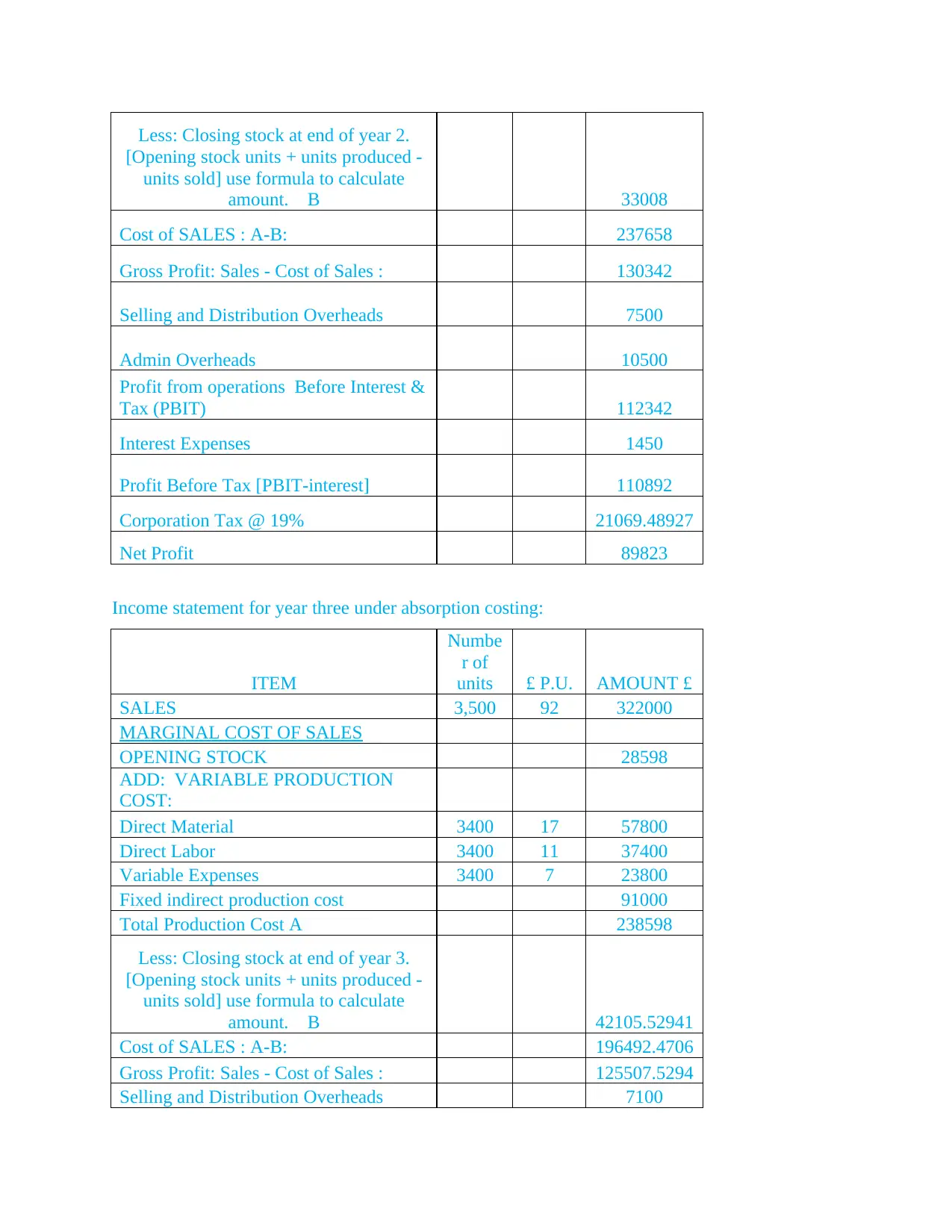
Less: Closing stock at end of year 2.
[Opening stock units + units produced -
units sold] use formula to calculate
amount. B 33008
Cost of SALES : A-B: 237658
Gross Profit: Sales - Cost of Sales : 130342
Selling and Distribution Overheads 7500
Admin Overheads 10500
Profit from operations Before Interest &
Tax (PBIT) 112342
Interest Expenses 1450
Profit Before Tax [PBIT-interest] 110892
Corporation Tax @ 19% 21069.48927
Net Profit 89823
Income statement for year three under absorption costing:
ITEM
Numbe
r of
units £ P.U. AMOUNT £
SALES 3,500 92 322000
MARGINAL COST OF SALES
OPENING STOCK 28598
ADD: VARIABLE PRODUCTION
COST:
Direct Material 3400 17 57800
Direct Labor 3400 11 37400
Variable Expenses 3400 7 23800
Fixed indirect production cost 91000
Total Production Cost A 238598
Less: Closing stock at end of year 3.
[Opening stock units + units produced -
units sold] use formula to calculate
amount. B 42105.52941
Cost of SALES : A-B: 196492.4706
Gross Profit: Sales - Cost of Sales : 125507.5294
Selling and Distribution Overheads 7100
[Opening stock units + units produced -
units sold] use formula to calculate
amount. B 33008
Cost of SALES : A-B: 237658
Gross Profit: Sales - Cost of Sales : 130342
Selling and Distribution Overheads 7500
Admin Overheads 10500
Profit from operations Before Interest &
Tax (PBIT) 112342
Interest Expenses 1450
Profit Before Tax [PBIT-interest] 110892
Corporation Tax @ 19% 21069.48927
Net Profit 89823
Income statement for year three under absorption costing:
ITEM
Numbe
r of
units £ P.U. AMOUNT £
SALES 3,500 92 322000
MARGINAL COST OF SALES
OPENING STOCK 28598
ADD: VARIABLE PRODUCTION
COST:
Direct Material 3400 17 57800
Direct Labor 3400 11 37400
Variable Expenses 3400 7 23800
Fixed indirect production cost 91000
Total Production Cost A 238598
Less: Closing stock at end of year 3.
[Opening stock units + units produced -
units sold] use formula to calculate
amount. B 42105.52941
Cost of SALES : A-B: 196492.4706
Gross Profit: Sales - Cost of Sales : 125507.5294
Selling and Distribution Overheads 7100
Paraphrase This Document
Need a fresh take? Get an instant paraphrase of this document with our AI Paraphraser
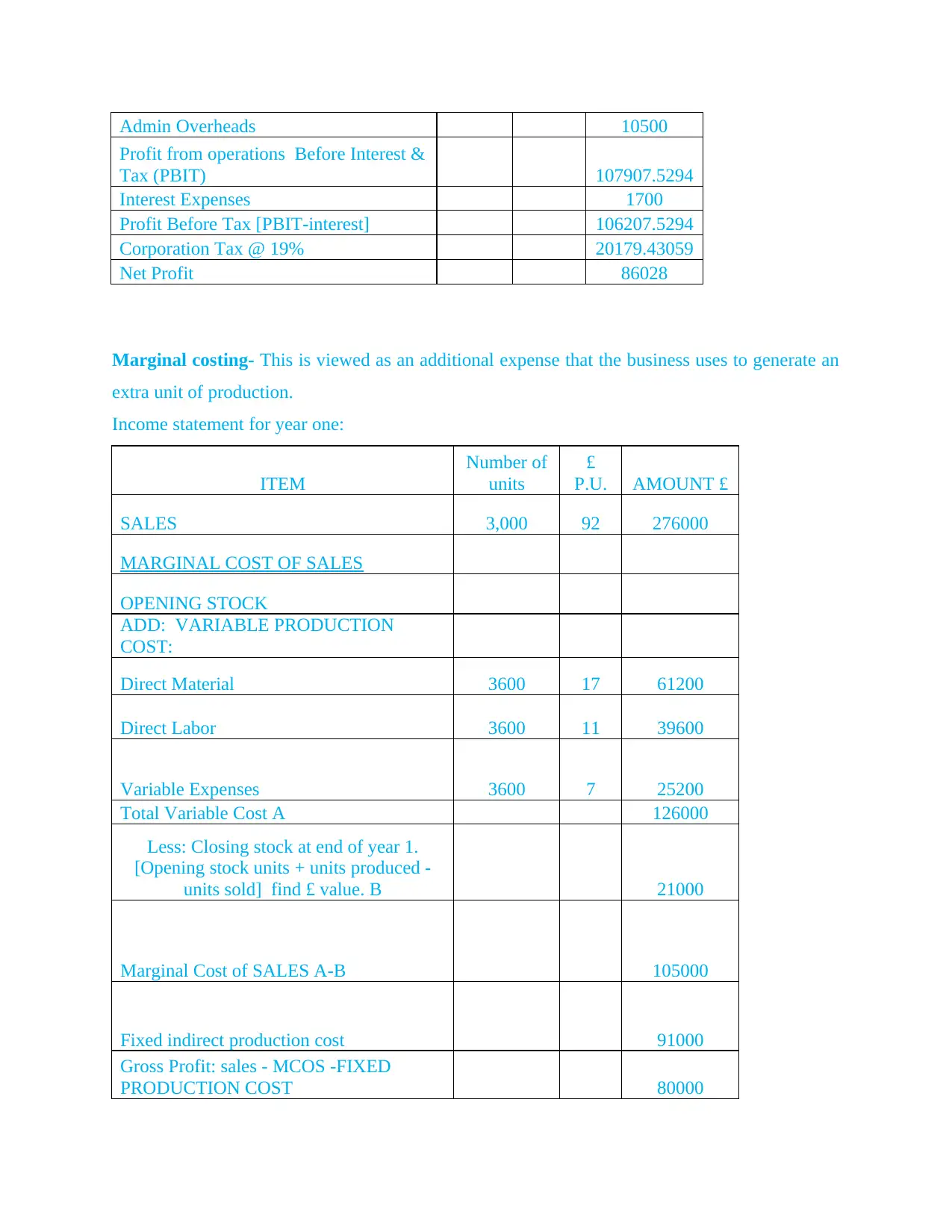
Admin Overheads 10500
Profit from operations Before Interest &
Tax (PBIT) 107907.5294
Interest Expenses 1700
Profit Before Tax [PBIT-interest] 106207.5294
Corporation Tax @ 19% 20179.43059
Net Profit 86028
Marginal costing- This is viewed as an additional expense that the business uses to generate an
extra unit of production.
Income statement for year one:
ITEM
Number of
units
£
P.U. AMOUNT £
SALES 3,000 92 276000
MARGINAL COST OF SALES
OPENING STOCK
ADD: VARIABLE PRODUCTION
COST:
Direct Material 3600 17 61200
Direct Labor 3600 11 39600
Variable Expenses 3600 7 25200
Total Variable Cost A 126000
Less: Closing stock at end of year 1.
[Opening stock units + units produced -
units sold] find £ value. B 21000
Marginal Cost of SALES A-B 105000
Fixed indirect production cost 91000
Gross Profit: sales - MCOS -FIXED
PRODUCTION COST 80000
Profit from operations Before Interest &
Tax (PBIT) 107907.5294
Interest Expenses 1700
Profit Before Tax [PBIT-interest] 106207.5294
Corporation Tax @ 19% 20179.43059
Net Profit 86028
Marginal costing- This is viewed as an additional expense that the business uses to generate an
extra unit of production.
Income statement for year one:
ITEM
Number of
units
£
P.U. AMOUNT £
SALES 3,000 92 276000
MARGINAL COST OF SALES
OPENING STOCK
ADD: VARIABLE PRODUCTION
COST:
Direct Material 3600 17 61200
Direct Labor 3600 11 39600
Variable Expenses 3600 7 25200
Total Variable Cost A 126000
Less: Closing stock at end of year 1.
[Opening stock units + units produced -
units sold] find £ value. B 21000
Marginal Cost of SALES A-B 105000
Fixed indirect production cost 91000
Gross Profit: sales - MCOS -FIXED
PRODUCTION COST 80000
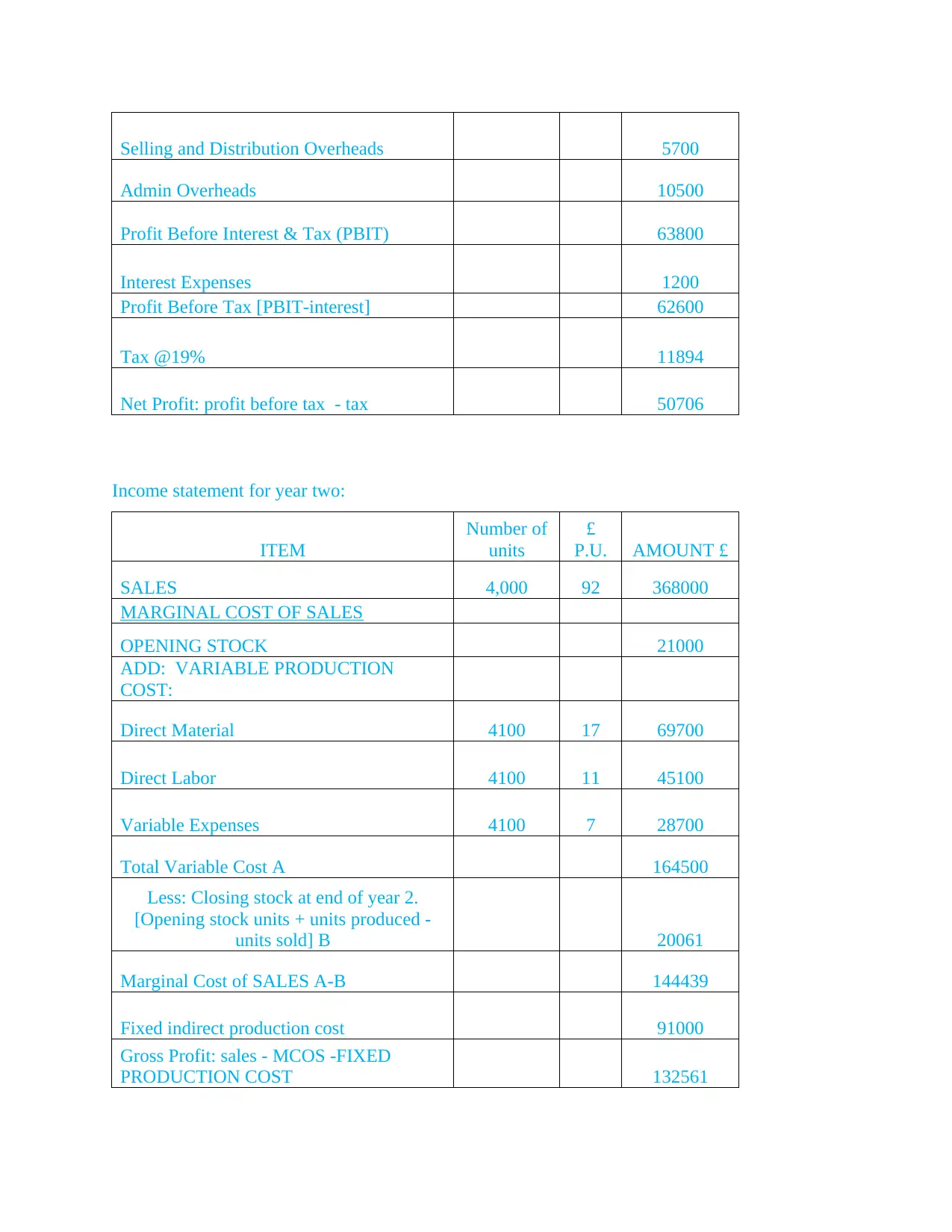
Selling and Distribution Overheads 5700
Admin Overheads 10500
Profit Before Interest & Tax (PBIT) 63800
Interest Expenses 1200
Profit Before Tax [PBIT-interest] 62600
Tax @19% 11894
Net Profit: profit before tax - tax 50706
Income statement for year two:
ITEM
Number of
units
£
P.U. AMOUNT £
SALES 4,000 92 368000
MARGINAL COST OF SALES
OPENING STOCK 21000
ADD: VARIABLE PRODUCTION
COST:
Direct Material 4100 17 69700
Direct Labor 4100 11 45100
Variable Expenses 4100 7 28700
Total Variable Cost A 164500
Less: Closing stock at end of year 2.
[Opening stock units + units produced -
units sold] B 20061
Marginal Cost of SALES A-B 144439
Fixed indirect production cost 91000
Gross Profit: sales - MCOS -FIXED
PRODUCTION COST 132561
Admin Overheads 10500
Profit Before Interest & Tax (PBIT) 63800
Interest Expenses 1200
Profit Before Tax [PBIT-interest] 62600
Tax @19% 11894
Net Profit: profit before tax - tax 50706
Income statement for year two:
ITEM
Number of
units
£
P.U. AMOUNT £
SALES 4,000 92 368000
MARGINAL COST OF SALES
OPENING STOCK 21000
ADD: VARIABLE PRODUCTION
COST:
Direct Material 4100 17 69700
Direct Labor 4100 11 45100
Variable Expenses 4100 7 28700
Total Variable Cost A 164500
Less: Closing stock at end of year 2.
[Opening stock units + units produced -
units sold] B 20061
Marginal Cost of SALES A-B 144439
Fixed indirect production cost 91000
Gross Profit: sales - MCOS -FIXED
PRODUCTION COST 132561
⊘ This is a preview!⊘
Do you want full access?
Subscribe today to unlock all pages.

Trusted by 1+ million students worldwide
1 out of 21
Related Documents
Your All-in-One AI-Powered Toolkit for Academic Success.
+13062052269
info@desklib.com
Available 24*7 on WhatsApp / Email
![[object Object]](/_next/static/media/star-bottom.7253800d.svg)
Unlock your academic potential
Copyright © 2020–2025 A2Z Services. All Rights Reserved. Developed and managed by ZUCOL.





